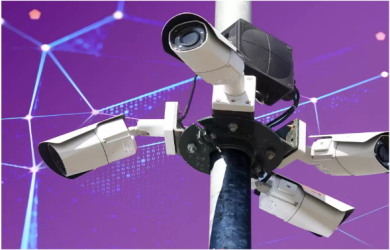 Many new and interesting use cases of CCTV cameras have come to the forefront in the last couple of years. For example, they are used in monitoring social distancing in public places as part of COVID 19 prevention measures, as well as in hospitals where the risk can be high. CCTV continues to provide both added security and convenience to our lives. As the sophistication of video surveillance systems continues to grow, and with the introduction of AI, the industry is moving to what is known as smart video solutions. In general, a smart video-based camera system makes use of video cameras, also called surveillance cameras, transmits the signal to a monitor or set of monitors, and gives real-time 24/7 viewing access.
Many new and interesting use cases of CCTV cameras have come to the forefront in the last couple of years. For example, they are used in monitoring social distancing in public places as part of COVID 19 prevention measures, as well as in hospitals where the risk can be high. CCTV continues to provide both added security and convenience to our lives. As the sophistication of video surveillance systems continues to grow, and with the introduction of AI, the industry is moving to what is known as smart video solutions. In general, a smart video-based camera system makes use of video cameras, also called surveillance cameras, transmits the signal to a monitor or set of monitors, and gives real-time 24/7 viewing access.
For a business or enterprise customer, deciding which video security system is best for one’s unique requirements, one must consider the following five essential components:
Camera
There are two camera options for choosing a CCTV camera: Internet Protocol (IP) or analog. IP cameras are feature rich and are gaining popularity and have revolutionized the adoption of video surveillance solutions. IP cameras capture high-definition footage, images and sharper video details. These cameras also offer analytics capabilities such as data for video analytics, real-time automatic alerts, etc. Another key advantage is that a new IP camera can be added to the current network at any time and will be recognized by the recorder. IP camera adoption is becoming widespread as these cameras become more affordable. Analog cameras are the traditional cameras that have been used in CCTV deployments are being phased out slowly.
One can decide on the camera depending on their requirements and the kind of monitoring that is needed. The number of cameras will depend on the angles and area to be covered and the resolution required.
2. Monitoring Station
Once the decision is made on which kind of camera to use, the next step is to set up a monitoring station. The number of monitors will again depend on angles and area covered and the image resolution required. You wouldn’t need more than three to five screens if you aren’t operating in a large-scale facility. Moreover, it is easy to scale up or down the number of monitors as needed.
Another factor is whether you plan to do remote monitoring through a smartphone, tablet, or computer. For example, if there are elderly parents, children or pets at home, then remote monitoring may be needed. This enables one to watch live video or even set up a real-time alert system, in case something requires faster attention, when it is not possible to watch live videos.
3.Video Recorders
Video is recorded on a device known as a video recorder, where video is stored for processing and viewing. There are two types of video recorders: DVR (Digital Video Recorders) and NVR (Network Video Recorders). The DVR system processes data at the recorder, while the NVR system encrypts and processes data in the camera before sending it to the recorder for storage and remote viewing.
4. Data Storage
Data plays a significant role in the smart video solution industry. Video needs to be stored for analysis either at on-premises or in the cloud. Businesses must factor in building a reliable, scalable, and most-often, customized data storage solution(s) that can help store and analyse the raw footage. The absence of proper data storage can make AI-powered smart video solutions very limited in scope. There are variety of storage solutions for different kinds of smart video or CCTV systems. The digital video recorder (DVR), or a network video recorder (NVR) that houses the storage will need to support the right capacity and reliability, so that the recording can be retained for a desired period.
Data is being generated, captured and storage from multiple sources – from endpoints to the edge and in the cloud. Western Digital provides flash-based storage solutions in the form of WD Purple® microSD™ cards up to 1TB[1] for the edge and endpoints requirements and WD Purple HDDs up to 18TB for NVRs and video analytics appliances.
5. Routers and Wires
Supporting technologies including cables and routers will be needed for a seamless connection, depending on the type of camera and systems chosen. For example, wireless systems will require a router. A security integrator can help in choosing equipment and managing the deployment.
Conclusion
Businesses are best served to invest in the right cameras, monitors, storage, and recorders, based on the technologies outlined here. A CCTV camera system and advanced smart video solutions are an integral part of improving one’s life, whether at home, work, or out in the community.
[1] One terabyte (TB) is equal to one trillion bytes. Actual user capacity may be less due to operating environment. Newspatrolling.com News cum Content Syndication Portal Online
Newspatrolling.com News cum Content Syndication Portal Online






